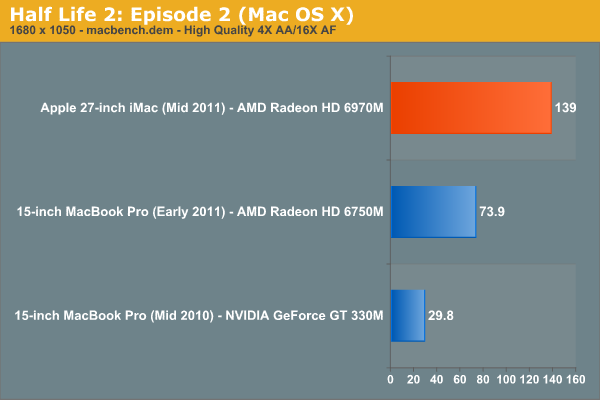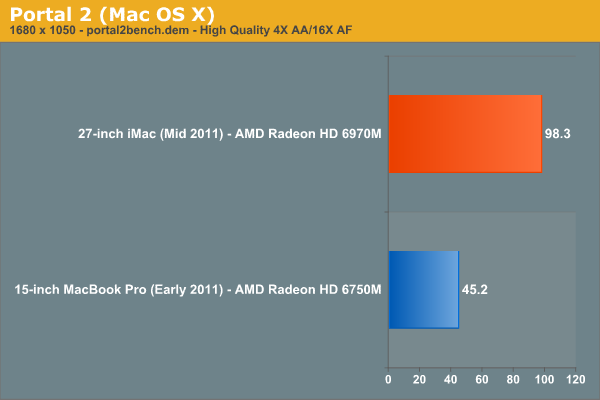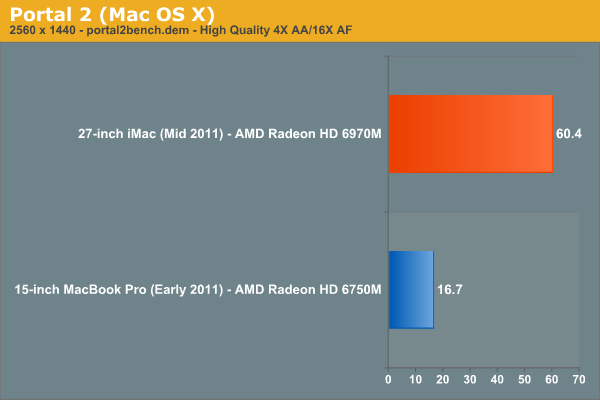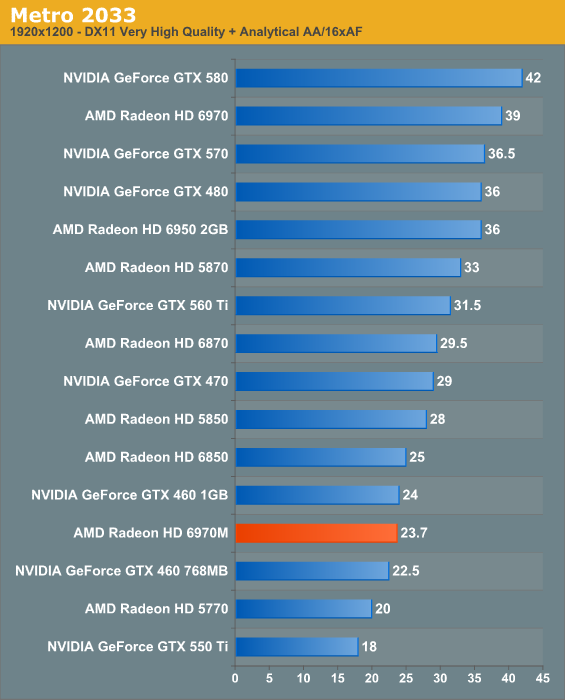The 27-inch Apple iMac Review (2011)
by Anand Lal Shimpi on May 27, 2011 2:30 AM ESTThe GPU
There are four discrete GPUs Apple offers in the new iMac and they're all from AMD, NVIDIA is completely out of the 2011 Apple lineup at this point. The entry level 21.5-inch iMac has the same Radeon HD 6750M as the upgraded 15-inch MacBook Pro. You can get a higher clocked 6770M in the upgraded 21.5 and base 27-inch models, and finally only the upgraded 27-inch iMac comes with a Radeon HD 6970M.
| GPU Options | |||||
| AMD Radeon HD 6750M | AMD Radeon HD 6770M | AMD Radeon HD 6970M | |||
| Manufacturing Process | 40nm | 40nm | 40nm | ||
| SPs | 480 | 480 | 960 | ||
| Texture Units | 24 | 24 | 48 | ||
| ROPs | 8 | 8 | 32 | ||
| Core Clock | 650MHz | 725MHz | 680MHz | ||
| Memory Bus Width | 128-bit | 128-bit | 256-bit | ||
| Memory Clock | 900MHz | 900MHz | 900MHz | ||
| Frame Buffer | 512MB GDDR5 | 512MB GDDR5 | 1024MB GDDR5 | ||
The 6970M doubles the number of shaders to 960 and doubles the memory bus width to 256-bits. The result is a GPU that has the fillrate and memory bandwidth to actually drive the 27-inch 2560 x 1440 panel...on sufficiently light games.
It's not all about compute and bandwidth, memory size matters as well. Unfortunately other than the upgraded 27-inch system, everything else only ships with a 512MB frame buffer. That's enough to drive the integrated panel but if you're running a high resolution external display as well you may notice some slowdown.
The upgraded 27-inch iMac can also be outfitted with an optional 2GB frame buffer for an extra $100. The added GB is nice but likely only useful if you have a specific application need or are running multiple displays.
| 2011 iMac GPU Comparison | ||||||
| iMac Model | $1199 21.5-inch | $1499 21.5-inch | $1699 27-inch | $1999 27-inch | ||
| Base GPU | AMD Radeon HD 6750M (512MB) | AMD Radeon HD 6770M (512MB) | AMD Radeon HD 6770M (512MB) | AMD Radeon HD 6970M (1GB) | ||
| GPU Upgrade Offered | None | None | None | AMD Radeon HD 6970M (2GB) | ||
Apple sent us the upgraded 27-inch model because 1) I asked for it and 2) Apple thinks I really care about performance. Both are indeed true. The question I wanted to answer was whether or not the Radeon HD 6970M was going to be sufficient for panel-resolution (2560 x 1440) gaming on the 27-inch iMac both now and in the future. I don't have any older iMacs handy so unfortunately we'll have to do our GPU comparisons to the MacBook Pro line.
We'll start with Half Life 2 Episode 2. A game that's definitely long in the tooth but still represents a good workload for a Source engine game on Steam. It doesn't make sense running at resolutions below 1680 x 1050 on a 27-inch panel and thankfully the 6970M does a good job here:

While even the Radeon HD 6750M can manage a respectable 73.9 fps in our test, the 6970M offers nearly double that at 139 fps.
| Half Life 2 Episode Two High Quality Settings | |||
| 2560 x 1440 - 4X AA/16X AF | |||
| 27-inch iMac (Mid 2011) - AMD Radeon HD 6970M | 112.8 fps | ||
Running at native panel resolution, the 27-inch iMac is still very playable under Half Life 2.

Moving to a more modern Source engine game: Portal 2, shows that yes you still get playable frame rates at low and high resolutions although maxed out I could only manage 60 fps on the iMac. This is far superior to the 6750M which struggles at our highest quality settings, but at 60 fps there isn't much room to grow in game complexity before the 6970M begins showing its limits.

In fact we already see those limits with Starcraft 2:
| Starcraft 2 - 2560 x 1440 - Ultra Quality Settings | ||||
| AT CPU Bench | AT GPU Bench | |||
| 27-inch iMac (Mid 2011) - AMD Radeon HD 6970M | 37 fps | 51 fps | ||
37 - 51 fps isn't the sort of buttery smoothness we've come to expect from a high end Sandy Bridge system running this game. It is very tough to drive the number of pixels we're talking about at native panel resolution. Thankfully for a game like Starcraft 2, as long as you're above 30 fps you're in good company. Drop the resolution to 1680 x 1050 and the 6970M looks a lot better:


I threw Windows 7 on the machine to put its GPU performance in perspective. Looking at Metro 2033 performance you get a good idea for where the 6970M falls compared to the performance mainstream to high end desktop GPUs we talk about regularly:


Overall performance is comparable to that of a GeForce GTX 460, which is still a great card - just not what we'd pick for driving a panel of this resolution. This is ultimately my issue with the GPU choices Apple offers with the new iMac: they are fast enough for most gaming on the Mac today, but likely aren't enough for panel resolution gaming for anything more strenuous (without dropping image quality). You can forget about most modern titles under Windows at panel resolution.










139 Comments
View All Comments
dagamer34 - Friday, May 27, 2011 - link
It's a desktop CPU, but a laptop GPU, and it really shows on page 4 when comparing the 6970M against desktop card. When you've spent $2000 on a machine with the same graphical performance as a $160 video card, that's when you REALLY know that Macs are NOT meant for gaming.That's why instead of buying an 27" iMac for gaming, I bought a 27" ACD and built a gaming PC. Same price, but PC parts (especially GPU) are upgradable, and since the computer isn't attached to the monitor, it retains it's value a LOT more.
Penti - Friday, May 27, 2011 - link
I would prefer the Dell U2711 here, as it's about 450 dollars less here in Sweden with Apples fucked up pricing tied to old exchange rate. Neither is it too fun with a 1650 dollar screen with just mini-displayport input. (Of which 25% VAT is included).Kristian Vättö - Friday, May 27, 2011 - link
Not a big deal but I thought I would add them anyway. On first page, you say 15" MBP has AMD 6770M while it really has 6750M. Scroll down to the HD part of the first page and it says the base 21.5" comes with 512GB HD, while it is a 500GB.For anyone who says I'm nitpicking, I'm not. I have written articles myself and I have made typos too. Look at the Ivy Bridge/Panther Point article's comments if you don't believe (I typoed that IB IGP will have OpenCL 10.1 :D). Like I said, it isn't a big deal but personally, I appreciate if someone points out my typos in a friendly matter.
BTW, Anand, you look like the mafia boss of SSDs in the FaceTime pic :D SSDs for every finger.
tipoo - Friday, May 27, 2011 - link
Also on the GPU page, "The entry level 21.5-inch MacBook Pro "...Now that would be an interesting product, lol.awaken688 - Friday, May 27, 2011 - link
"I've always kept displays through several upgrades, but you can't really do that with an iMac. I'm not really sure how to come to terms with that aspect of what Apple is offering here."That is the key statement. You have a nice $1000 monitor, but you have to sell it to upgrade (yeah, you can use it again, but you have a whole computer in the back). So you take depreciation on your hardware and depreciation on your monitor. Then you get another iMac and repeat. In the PC world of desktops, you get a nice monitor and only take depreciation one time on the monitor. Over 3 upgrade cycles, that can be $500-$1000 in savings over the iMac solution depending on the quality of the monitors. That is a big deal. MacBook Pros make perfect sense to me, but Apple just does not offer a desktop model that fits my needs. Mini is too slow and Mac Pro has Xeon cores which I refuse to pay for as I don't need them. I won't hold my breath for Apple to fill in my needs.
Kristian Vättö - Friday, May 27, 2011 - link
Mac Pros just have an extremely fat profit margin, nothing else. Xeon 3000-series CPUs cost as much as their Core iX counterparts. For example the W3530 used in base Mac Pro costs 294$, which is the same as what i7-930 costs. Dell sells a similarly equipped workstation for around 1500$, and yes, that includes Xeons, ECC RAM, workstation GPU (something that MP doesn't have) etc.It's obvious that iMac is Apple's flagship in consumer desktop market. They have shown zero interest towards a mid-tower though why would they? iMac is selling brilliantly.
dagamer34 - Friday, May 27, 2011 - link
At this point, Mac Pros are pretty much in dire need for a price adjustment. Even if you really do need all that power, I think buying it makes you feel silly compared to what is available in the MacBook Pros and iMacs of today. And with Thunderbolt, the biggest reason to buy a Mac Pro has disappeared (high speed i/o cards).Penti - Friday, May 27, 2011 - link
Well when they still where new, the dual processor models where priced competitively against real HP and Dell workstations which often even did cost a bit more. The problem here are two things, the single processor model is just rubbish and priced about 1000 dollars too much (a year ago or even two years ago) and that Apple never adjusts the price of a model but instead replaced them with a new one. With a new price.A single socket Mac pro shouldn't be more then a C i7 2600K for like 1200 dollars now, a extreme edition SNB would cost some additional 700 dollars, dual processor model should use something like Westmere-EX by now. 10-core (6-10C) two socket support and quad-channel memory. Why mess around with LGA2011 or LGA1366 today? They pretty much have no choice but to go real high-end or use normal desktop parts with the Mac Pro update. There are no Sandy-Bridge workstation class processors. And dual 8C Westmere-EX would end up costing something like 6000 dollars for the machine though. There's just no good workstation hardware competitively priced there to begin with right now. Right now it doesn't get better then dual Westmere 2.93GHz as the Mac Pro uses. AMD HD6970, two 8-core Westmere-EX is pretty much as far they could go today/this year and that would end up costing at least above 5000 dollars. Just leaving iMac comfortably under that as workstation. But they probably won't upgrade that until sometime after Lion any way.
KoolAidMan1 - Friday, May 27, 2011 - link
The thing is that depreciation on the iMac is much much slower than it is with PC parts. I sell my iMac and my gaming PC components at roughly the same time, and what I make back selling the old iMac is significantly higher than what I sell my PC parts for.Getting a high resale return on my old 24" iMac and using the proceeds to get a new 27" iMac with that gorgeous display was a great deal, and it actually sold me (I was skeptical too) on the idea of upgrading all-in-ones by selling the whole thing on ebay. Getting a similar return on my PC is just not possible.
tipoo - Friday, May 27, 2011 - link
Does anyone know if the GPU switching is enabled in the iMac's? They didn't mention the HD graphics on the spec page unlike the MBP's, so maybe they didn't bother with it since there is no battery. Also most of them use the HD2000 which is half as powerful as the HD3000, so maybe it didn't meet their requirements even for basic desktop work.